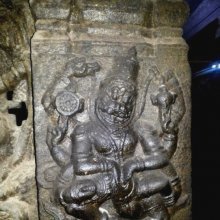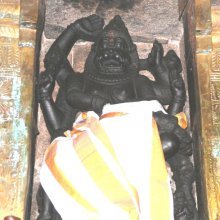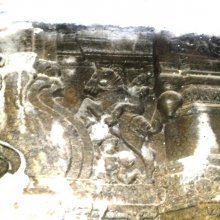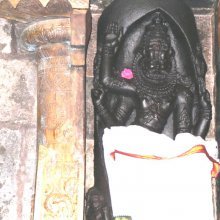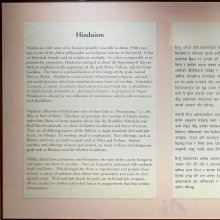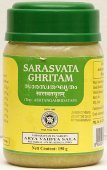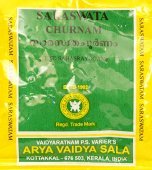Ugra, Ugrā: 42 definitions
Introduction:
Ugra means something in Buddhism, Pali, Hinduism, Sanskrit, Jainism, Prakrit, Marathi, Hindi, biology. If you want to know the exact meaning, history, etymology or English translation of this term then check out the descriptions on this page. Add your comment or reference to a book if you want to contribute to this summary article.
Images (photo gallery)
(+2 more images available)
In Hinduism
Natyashastra (theatrics and dramaturgy)
Source: Wisdom Library: Nāṭya-śāstraUgra (उग्र) is the Sanskrit name of one of Bharata’s sons, mentioned in the Nāṭyaśāstra 1.26-33. After Brahmā created the Nāṭyaveda (nāṭyaśāstra), he ordered Bharata to teach the science to his (one hundred) sons. Bharata thus learned the Nāṭyaveda from Brahmā, and then made his sons study and learn its proper application. After their study, Bharata assigned his sons (eg., Ugra) various roles suitable to them.
Source: Wisdom Library: SaṅgītaśiromaṇiUgra (उग्र) refers to one of the twenty-two quarters tones (śruti) existing within an octave, according to the Saṅgīta-ratnākara (“ocean of music and dance”). This work is an important Sanskrit treatise dealing with ancient Indian musicology (gāndharva-śāstra), composed by Śārṅgadeva in the 13th century and deals with both Carnatic and Hindustani music. Ugra has a frequency of 441.4931Hz.
Source: archive.org: The mirror of gesture (abhinaya-darpana)A type of glance (or facial expression): Ugra (fierce): very wide open, a httle red at the comers. Usage: ferocity.

Natyashastra (नाट्यशास्त्र, nāṭyaśāstra) refers to both the ancient Indian tradition (shastra) of performing arts, (natya—theatrics, drama, dance, music), as well as the name of a Sanskrit work dealing with these subjects. It also teaches the rules for composing Dramatic plays (nataka), construction and performance of Theater, and Poetic works (kavya).
Shilpashastra (iconography)
Source: Wisdom Library: Elements of Hindu IconograpyUgra (उग्र):—One of the eight names of Rudra, given to him by Brahmā, according to the Pādma-purāṇa. This aspect became the presiding deity over the brāhmaṇas who had performed sacrifices. The corresponding name of the consort is Dīkṣā. His son is called Santāna.
Source: archive.org: Illustrations of Indian Music and Dance in Western Indian StyleUgrā (उग्रा, “mighty”).—Illustration of Ugrā-śruti according to 15th century art:—The colour of her body is golden. She holds a flower in her right hand and a vīṇā in the left. The colour of her bodice is green and the scarf is rosy with a crimson-coloured design and the golden border; the lower garment is sky-blue with a black-coloured design.
The illustrations (of, for example Ugrā) are found scattered throughout ancient Jain manuscripts from Gujarat. The descriptions of these illustrations of this citrāvalī are based on the ślokas of Vācanācārya Gaṇi Sudhākalaśa’s Saṅgītopaniṣatsāroddhāra (14th century) and Śārṅgadeva’s Saṅgītaratnākara (13th century).

Shilpashastra (शिल्पशास्त्र, śilpaśāstra) represents the ancient Indian science (shastra) of creative arts (shilpa) such as sculpture, iconography and painting. Closely related to Vastushastra (architecture), they often share the same literature.
Dharmashastra (religious law)
Source: Wisdom Library: Dharma-śāstraUgra (उग्र) is a Sanskrit word referring to either 1) “one who does cruel deeds”, or 2) “one who is born of a Kṣatriya father and Vaiśya mother”, or 3) “a king”. The word is used throughout Dharmaśāstra literature such as the Manusmṛti. (also see the Manubhāṣya verse 4.212)
Source: Google Books: Manusmṛti with the ManubhāṣyaUgra (उग्र) is the name of a special sub-caste. In the Veda, the term is applied to a kind of king, one who forms the central link in the chain of the king’s alliance. There is no other prohibition regarding such a king; it is only in course of showing the evils arising from eating the food of such kings that we rend—‘the food given by kings deprives one of one’s energy,’ from which some sort of prohibition may be inferred. (See the Manubhāṣya verse 4.212)

Dharmashastra (धर्मशास्त्र, dharmaśāstra) contains the instructions (shastra) regarding religious conduct of livelihood (dharma), ceremonies, jurisprudence (study of law) and more. It is categorized as smriti, an important and authoritative selection of books dealing with the Hindu lifestyle.
Purana and Itihasa (epic history)
Source: archive.org: Puranic Encyclopedia1) Ugra (उग्र).—A military captain of Śūrapadmāsura, Chief of asuras. In the Vīramahendra Kāṇḍa of Skanda Purāṇa, two warriors, Ugra and Mayūra are reported to have attacked Indrapurī.
2) Ugra (उग्र).—One of the sons of Dhṛtarāṣṭra. (Mahābhārata Ādi Parva, Chapter 67, Verse 103). Bhīmasena killed him (Mahābhārata Bhīṣma Parva, Chapter 64, Verses 34, 35).
3) Ugra (उग्र).—A Yādava prince. The Pāṇḍavas sent to him also an invitation letter to help them in the war. (Mahābhārata Udyoga Parva, Chapter 4, Verse 12).
4) Ugra (उग्र).—A synonym of Lord Śiva. (Mahābhārata Anuśāsana Parva, Chapter 17, Verse 100).
5) Ugra (उग्र).—Son of Kavi, the Prajāpati. (Mahābhārata Anuśāsana Parva, Chapter 85, Verse 133).
6) Ugra (उग्र).—See under Varṇa.
Source: archive.org: Shiva Purana - English TranslationUgra (उग्र) refers to a form of Śiva, according to the Śivapurāṇa 2.2.41.—Accordingly, as Viṣṇu and others eulogized Śiva:—“[...] obeisance to Ugra in the form of Sun; obeisance to you the detached performer of actions, the slayer of Kāla, and the furious Rudra. Obeisance to Śiva, Bhīma, Ugra, the controller of living beings; you are Śiva to us”.
Source: Cologne Digital Sanskrit Dictionaries: The Purana Index1a) Ugra (उग्र).—A Rudra; son of Bhūta and Sarūpā;1 an Amitābha deva.2
- 1) Bhāgavata-purāṇa VI. 6. 17; Brahmāṇḍa-purāṇa IV. 34. 41; Viṣṇu-purāṇa I. 8. 6.
- 2) Brahmāṇḍa-purāṇa II. 36. 53.
1b) A Marut of the third gaṇa.*
- * Brahmāṇḍa-purāṇa III. 5. 94; Vāyu-purāṇa 67. 126.
1c) A son of Yātudhāna; father of Vajrahā.*
- * Brahmāṇḍa-purāṇa III. 7. 89 and 92.
1d) A manifestation of Śiva, and the presiding deity of yajamāna (adhivāsa)1 wife Dīkṣā and son Santāna;2 the seventh name of Mahādeva.3
- 1) Matsya-purāṇa 265. 41; Vāyu-purāṇa 27. 15.
- 2) Vāyu-purāṇa 27. 55; Brahmāṇḍa-purāṇa II. 10. 83.
- 3) Brahmāṇḍa-purāṇa II. 10. 16.
1e) An avatār of the lord in the Gaṅgādvāra in the eleventh dvāpara with four sons.*
- * Vāyu-purāṇa 23. 152.
1f) An Asura.*
- * Viṣṇu-purāṇa V. 1. 24.
2a) Ugrā (उग्रा).—A śakti.*
- * Brahmāṇḍa-purāṇa IV. 44. 73.
2b) A piśāca kanyā.*
- * Vāyu-purāṇa 69. 127.
Ugra (उग्र) is a name mentioned in the Mahābhārata (cf. I.108.12) and represents one of the many proper names used for people and places. Note: The Mahābhārata (mentioning Ugra) is a Sanskrit epic poem consisting of 100,000 ślokas (metrical verses) and is over 2000 years old.
Source: Shodhganga: The saurapurana - a critical studyUgra (उग्र) is the deity to be worshipped in the month Āṣāḍha for the Anaṅgatrayodaśī-Vrata, according to the 10th century Saurapurāṇa: one of the various Upapurāṇas depicting Śaivism.—Accordingly, the Anaṅgatrayodaśī-vrata is observed in honour of Śiva for acquiring virtue, great fortune, wealth and for destruction of sins [...] This vrata is to be performed for a year from Mārgaśīra.—In Āṣāḍha, food is gomaya, the deity is Ugra result is eight times that of śautrāmaṇi.

The Purana (पुराण, purāṇas) refers to Sanskrit literature preserving ancient India’s vast cultural history, including historical legends, religious ceremonies, various arts and sciences. The eighteen mahapuranas total over 400,000 shlokas (metrical couplets) and date to at least several centuries BCE.
Shaivism (Shaiva philosophy)
Source: Wisdom Library: Śaivism1) Ugra (उग्र) is the Sanskrit name of a deity presiding over Koṭitīrtha, one of the sixty-eight places hosting a svāyambhuvaliṅga, which is one of the most sacred of liṅgas according to the Śaivāgamas. The list of sixty-eight svāyambhuvaliṅgas and presiding deities (e.g., Ugra) is found in the commentary on the Jirṇoddhāra-daśaka by Nigamajñānadeva. The word liṅga refers to a symbol used in the worship of Śiva and is used thoughout Śaiva literature, such as the sacred Āgamas.
2) Ugra (उग्र) refers to one of the “eight lords of divisions” (vigraheśvara) associated with the so-called eight divisions (vigraha) according to the Mataṅgapārameśvara (1.8.83–5). These “eight lords of divisions” are also mentioned in a copper-plate inscription found in Malhar, Chhattisgarh, written around 650 CE. The eight divisions (vigraha) represent the uppermost part of the Lākulas’ impure universe.
All these manifestations of Śiva (e.g., Ugra) appear at the borders of various divisions of the universe according to the Lākula system.
Source: Shodhganga: Iconographical representations of ŚivaUgra (उग्र) is the name of a deity who received the Aṃśumadāgama from Ambu (Aṃśu) through the mahānsambandha relation, according to the pratisaṃhitā theory of Āgama origin and relationship (sambandha). The aṃśumat-āgama, being part of the ten Śivabhedāgamas, refers to one of the twenty-eight Siddhāntāgamas: a classification of the Śaiva division of Śaivāgamas. The Śaivāgamas represent the wisdom that has come down from lord Śiva, received by Pārvatī and accepted by Viṣṇu.
Ugra obtained the Aṃśumadāgama from Ambu (Aṃśu) who in turn obtained it from Sadāśiva through parasambandha. Ugra in turn, transmitted it to Ravi who then, through divya-sambandha, transmitted it to the Devas who, through divyādivya-sambandha, transmitted it to the Ṛṣis who finally, through adivya-sambandha, revealed the Aṃśumadāgama to human beings (Manuṣya). (also see Anantaśambhu’s commentary on the Siddhāntasārāvali of Trilocanaśivācārya)
Source: SOAS University of London: Protective Rites in the Netra TantraUgra (उग्र) refers to “terrible”, according to the Netratantra of Kṣemarāja: a Śaiva text from the 9th century in which Śiva (Bhairava) teaches Pārvatī topics such as metaphysics, cosmology, and soteriology.—Accordingly, [verse 9.19cd-26, while instructing to visualize Sadāśiva in order to worship the formless Amṛteśa]—“[He] resembles the swelling moon, a heap of mountain snow. [...] [Sadāśiva has] a shield, a mirror, a bow, a citron tree, and a water jar. At his head is a half moon. [He who meditates of Sadāśiva] should perceive the Eastern face as yellow; the Southern a wrathful, terrible black (bhīma-ugra—kṛṣṇabhīmograṃ) [that has] an unnatural, tusked mouth. [...]”.

Shaiva (शैव, śaiva) or Shaivism (śaivism) represents a tradition of Hinduism worshiping Shiva as the supreme being. Closely related to Shaktism, Shaiva literature includes a range of scriptures, including Tantras, while the root of this tradition may be traced back to the ancient Vedas.
Pancaratra (worship of Nārāyaṇa)
Source: Wisdom Library: PāñcarātraUgra (उग्र) refers to an aspect of nṛsiṃha (‘man-lion’), according to the Vihagendra-saṃhitā 4.17, which mentions seventy-four forms (inlcuding twenty forms of vyūha). He is also known as Ugranṛsiṃha or Ugranarasiṃha. Nṛsiṃha is a Tantric deity and refers to the furious (ugra) incarnation of Viṣṇu.
The 15th-century Vihagendra-saṃhīta is a canonical text of the Pāñcarātra corpus and, in twenty-four chapters, deals primarely with meditation on mantras and sacrificial oblations.

Pancaratra (पाञ्चरात्र, pāñcarātra) represents a tradition of Hinduism where Narayana is revered and worshipped. Closeley related to Vaishnavism, the Pancaratra literature includes various Agamas and tantras incorporating many Vaishnava philosophies.
Jyotisha (astronomy and astrology)
Source: Wisdom Library: Brihat Samhita by VarahamihiraUgra (उग्र) means “severe” (i.e., ruling with a severe rod), according to the Bṛhatsaṃhitā (chapter 4), an encyclopedic Sanskrit work written by Varāhamihira mainly focusing on the science of ancient Indian astronomy astronomy (Jyotiṣa).—Accordingly, “If the two horns of the moon should appear but slightly raised and far from each other presenting the appearance of a boat, she brings trouble on the sailors but prosperity on mankind at large. [...] If, on the first lunar day after new moon, both horns should be alike and of equal height, there will be the same prosperity and rain throughout the month as on such first lunar day. If the moon should appear like a rod, the cattle will suffer and the sovereign will rule with a severe rod [i.e., ugra-daṇḍa]”.
Source: academia.edu: Tithikarmaguṇa in GārgīyajyotiṣaUgrā (उग्रा) or Ugratithi is the name of the fourteenth of fifteen tithis (cycle of time) according to both the Gārgīyajyotiṣa and the Śārdūlakarṇāvadāna. The associated deity for Ugrā according to the Bṛhatsaṃhitā is Kali. A tithi was defined as one thirtieth of a synodic month (c. 29.5 days), resulting in an average tithi being slightly less than a day.
Accordingly, “(37) One should know the fourteenth tithi as Ugrā. On this tithi one should perform cruel deeds and capture one's enemies. On this tithi one should avoid travel. (38) One should engage in preemptive attack, horrific killing by poisons and destruction of regional factions (lit. village army). One should know Rudra as the deity on this tithi”.

Jyotisha (ज्योतिष, jyotiṣa or jyotish) refers to ‘astronomy’ or “Vedic astrology” and represents the fifth of the six Vedangas (additional sciences to be studied along with the Vedas). Jyotisha concerns itself with the study and prediction of the movements of celestial bodies, in order to calculate the auspicious time for rituals and ceremonies.
Shaktism (Shakta philosophy)
Source: Google Books: ManthanabhairavatantramUgrā (उग्रा) refers to “the Goddess who is ferocious”, according to the Manthānabhairavatantra, a vast sprawling work that belongs to a corpus of Tantric texts concerned with the worship of the goddess Kubjikā.—Accordingly, “[...] O mother of Mitra! I salute the venerable goddess called Kujā, the lord who, full (of energy) (bharitā), is the ferocious (ugrā) Bhairavī who travels to the plane at the extremity of (the energy of the) New Moon (amā). I praise (the goddess) who, in the field at the extremity of the energy at the summit of the Moon is, by the process of going and coming (gamāgamakrama), divided by the divisions of will, knowledge and action [...]”.—

Shakta (शाक्त, śākta) or Shaktism (śāktism) represents a tradition of Hinduism where the Goddess (Devi) is revered and worshipped. Shakta literature includes a range of scriptures, including various Agamas and Tantras, although its roots may be traced back to the Vedas.
Kavya (poetry)
Source: academia.edu: Gleanings from Atula’s MusikavamsaUgra (उग्र) is the name of an ancient king from Mūṣika, according to the historical poem Mūṣikavaṃśa by Atula dealing with the royal lineage of North Kerala in roughly 1000 verses.—[...] [King Rāmaghaṭa] marries Suvarman’s daughter Bhadrasenā and installs his eldest son by her on the throne of Hehaya kingdom and returns to Mūṣika kingdom with his youngest son Nandana. Rāmaghaṭa retires to forest after making him the king. The pleasure loving Nandana was succeeded by a lineage, among whom were Ugra, Ugradhanvā, Siṃhasena, Candravarman, Bṛhatsuta and Ugrāśva. [...]

Kavya (काव्य, kavya) refers to Sanskrit poetry, a popular ancient Indian tradition of literature. There have been many Sanskrit poets over the ages, hailing from ancient India and beyond. This topic includes mahakavya, or ‘epic poetry’ and natya, or ‘dramatic poetry’.
Ayurveda (science of life)
Nighantu (Synonyms and Characteristics of Drugs and technical terms)
Source: WorldCat: Rāj nighaṇṭuUgrā (उग्रा) is another name for Yavānī, a medicinal plant identified with Trachyspermum ammi Linn. or “ajwain” from the Apiaceae or “celery” family of flowering plants, according to verse 6.38-40 of the 13th-century Raj Nighantu or Rājanighaṇṭu.—The sixth chapter (pippalyādi-varga) of this book enumerates ninety-five varieties of plants obtained from the market (paṇyauṣadhi). Together with the names Ugrā and Yavānī, there are a total of sixteen Sanskrit synonyms identified for this plant.
Toxicology (Study and Treatment of poison)
Source: Shodhganga: Kasyapa Samhita—Text on Visha ChikitsaUgra (उग्र) refers to one of the sixteen varieties of “rats” (Ākhu or Mūṣika), according to the Kāśyapa Saṃhitā: an ancient Sanskrit text from the Pāñcarātra tradition dealing with both Tantra and Viṣacikitsā—an important topic from Āyurveda which deals with the study of Toxicology (Viṣavidyā or Sarpavidyā).—The Kāśyapasaṃhitā seems to consider rat poison as the next powerful one, seriously affecting human beings. Kāśyapa gives antidotes for the 16 varieties of rats (e.g., Ugra). The author follows this up with certain general instructions in tackling poisons.
Symptoms of Ugra: Restlessness in the head, weakness, tastelessness, fever and indescribable pain and discomfort.
Treatment (Antidote) of Ugra: Must take a tablet or gulikā made from pearl and silver. Fruit and powder of the roots of Śvetaāśarapuṅkha and Kaṇṭhapuṅkha garnished with the bark of Pūtikā. Victim must be given a drink of gruel made of barley, Puṅkha and Ākhukarṇikā. The same can be used as ointment as well. Fumigation with jaggery and hair of mongoose prescribed. Curd must be taken.

Āyurveda (आयुर्वेद, ayurveda) is a branch of Indian science dealing with medicine, herbalism, taxology, anatomy, surgery, alchemy and related topics. Traditional practice of Āyurveda in ancient India dates back to at least the first millenium BC. Literature is commonly written in Sanskrit using various poetic metres.
General definition (in Hinduism)
Source: archive.org: Vedic index of Names and SubjectsUgra (उग्र) in one passage of the Bṛhadāraṇyaka Upaniṣad seems to have a technical force, denoting ‘man in authority,’ or according to Max Müller’s rendering, ‘policeman.’ Roth compares a passage in the Rigveda, where, however, the word has simply the general sense of “mighty man”. Böhtlingk, in his rendering of the Upaniṣad, treats the word as merely adjectival.
In Buddhism
Tibetan Buddhism (Vajrayana or tantric Buddhism)
Source: De Gruyter: A Fragment of the VajrāmṛtamahātantraUgrā (उग्रा) refers to one of the eight wisdoms (vidyās) described in the ‘śrīheruka-utpatti’ chapter of the 9th-century Vajrāmṛtatantra or Vajrāmṛtamahātantra: one of the main and earliest Buddhist Yoginītantras. Chapter 8 contains the description of how to visualise Śrīheruka [...] The great Vajra-holder should summon the Glorious form of Heruka, who is devouring the Devas together with Indra, Brahmā, Viṣṇu, and Śiva. Then the text lists the eight Wisdoms (vidyā) [viz., Ugrā], [...], expounds the words that the practitioner has to mutter when he is pushed by these wisdoms [...].

Tibetan Buddhism includes schools such as Nyingma, Kadampa, Kagyu and Gelug. Their primary canon of literature is divided in two broad categories: The Kangyur, which consists of Buddha’s words, and the Tengyur, which includes commentaries from various sources. Esotericism and tantra techniques (vajrayāna) are collected indepently.
In Jainism
General definition (in Jainism)
Source: archive.org: TrisastisalakapurusacaritraUgra (उग्र) refers to a sub-division of the Jātyārya class of Āryas (one of the two types of human beings), taking birth in the “middle world” (madhyaloka), according to chapter 2.3 [ajitanātha-caritra] of Hemacandra’s 11th century Triṣaṣṭiśalākāpuruṣacaritra: an ancient Sanskrit epic poem narrating the history and legends of sixty-three illustrious persons in Jainism.
Accordingly:—“In these 35 zones on this side of Mānuṣottara and in the Antaradvīpas, men arise by birth; [...]. From the division into Āryas and Mlecchas they are two-fold. The Āryas have sub-divisions: kṣetra (country), jāti (caste), kula (family), karma (work), śilpa (craft), and bhāṣā (language). [...] The Jātyāryas are the Ikṣvākus, Jñātas, Haris, Videhas, Kurus, Ugras, Bhojas, and Rājanyas”.

Jainism is an Indian religion of Dharma whose doctrine revolves around harmlessness (ahimsa) towards every living being. The two major branches (Digambara and Svetambara) of Jainism stimulate self-control (or, shramana, ‘self-reliance’) and spiritual development through a path of peace for the soul to progess to the ultimate goal.
Biology (plants and animals)
Source: Google Books: CRC World Dictionary (Regional names)1) Ugra in India is the name of a plant defined with Bidens pilosa in various botanical sources. This page contains potential references in Ayurveda, modern medicine, and other folk traditions or local practices It has the synonym Centipeda minuta (G. Forst.) C.B. Clarke (among others).
2) Ugra is also identified with Carum copticum It has the synonym Carum copticum (L.) Benth. & Hook. f. ex C.B. Clarke (etc.).
3) Ugra is also identified with Centipeda minima It has the synonym Myriogyne minuta (G. Forst.) Less. (etc.).
4) Ugra is also identified with Moringa ovalifolia It has the synonym Moringa pterygosperma Gaertner, nom. illeg. (etc.).
Example references for further research on medicinal uses or toxicity (see latin names for full list):
· Pflanzenw. Afr. (1921)
· Taxon (1981)
· Neue und wenig bekannte Pflanzen Deutsch-SüdwestAfrikas (1914)
· Bulletin de la Société Botanique de France (1963)
· Nova Genera et Species Plantarum (1820)
· Field Museum of Natural History, Botanical Series (1902)
If you are looking for specific details regarding Ugra, for example pregnancy safety, extract dosage, health benefits, diet and recipes, chemical composition, side effects, have a look at these references.

This sections includes definitions from the five kingdoms of living things: Animals, Plants, Fungi, Protists and Monera. It will include both the official binomial nomenclature (scientific names usually in Latin) as well as regional spellings and variants.
Languages of India and abroad
Marathi-English dictionary
Source: DDSA: The Molesworth Marathi and English Dictionaryugra (उग्र).—a (S) Fierce, ferocious, ogre-like--a person or disposition: frightful or hideous--a countenance, an appearance gen: rough, harsh, savage--speech, a voice: atrocious, appalling, shocking--an act or deed. 2 Strong--a smell: also strong-smelling.
--- OR ---
ugra (उग्र).—m S A mixed tribe, or an individual of it, from a kṣatriya father and śūdra mother.
Source: DDSA: The Aryabhusan school dictionary, Marathi-Englishugra (उग्र).—a Fierce, ferocious. Rough. Strong- smelling. Frightful.
Marathi is an Indo-European language having over 70 million native speakers people in (predominantly) Maharashtra India. Marathi, like many other Indo-Aryan languages, evolved from early forms of Prakrit, which itself is a subset of Sanskrit, one of the most ancient languages of the world.
Sanskrit dictionary
Source: DDSA: The practical Sanskrit-English dictionaryUgra (उग्र).—a. [uc-ran gaścāntādeśaḥ Uṇādi-sūtra 2.28]
1) Fierce, cruel, ferocious, savage (as a look &c.); °दर्शनः (darśanaḥ) having a fierce or cruel look.
2) Formidable, terrific, frightful; सिंहनिपातमुग्रम् (siṃhanipātamugram) R.2.5; Bhagavadgītā (Bombay) 11.3; Manusmṛti 6.75,12.75; °दन्तः, °नासिकः (dantaḥ, °nāsikaḥ) &c.
3) Powerful, mighty, strong, violent, intense; उग्रातपां वेलाम् (ugrātapāṃ velām) Ś.3 intensely hot. उग्रशोकाम् (ugraśokām) Meghadūta 115 v. l.; निखिलरसायनराजो गन्धेनोग्रेण लशुन इव (nikhilarasāyanarājo gandhenogreṇa laśuna iva) Bv. Sharp, pungent, hot,
5) High, noble. यत्र भगवानास्ते वाल्मीकिसुग्रधीः (yatra bhagavānāste vālmīkisugradhīḥ) Rām.7.49.1.
6) Angry, passionate, wrathful.
7) Ready to do any work, industrious.
-graḥ 1 Name of Śiva or Rudra; जघ्नेऽद्भुतैणवपुषाऽऽश्रमतोऽ- पकृष्टो मारीचमाशु विशिखेन यथा कमुग्रः (jaghne'dbhutaiṇavapuṣā''śramato'- pakṛṣṭo mārīcamāśu viśikhena yathā kamugraḥ) Bhāgavata 9.1.1.
2) Name of a mixed tribe, descendant of a Kṣatriya father and Śūdra mother (his business being to catch or kill animals dwelling in holes, such as snakes; cf. kṣatriyācchūdrakanyāyāṃ krūrācāravihāravān | kṣatraśūdra- vapurjanturugro nāma prajāyate || Manusmṛti 1.9,13,15.).
3) Name of a tree शोभाञ्जनवृक्ष (śobhāñjanavṛkṣa) (Mar. śevagā).
4) A group of five asterisms; their names are :पूर्वाफल्गुनी, पूर्वाषाढा, पूर्वाभाद्रपदा, मघा (pūrvāphalgunī, pūrvāṣāḍhā, pūrvābhādrapadā, maghā) and भरणी (bharaṇī).
5) Name of a country called Kerala (Modern Malabar).
6) The sentiment called रौद्र (raudra).
7) Wind.
8) A royal attendant (like ugra tribe); उग्राः प्रत्येनसः सूतग्रामण्यः (ugrāḥ pratyenasaḥ sūtagrāmaṇyaḥ) Bṛ. Up.4.3.37.
-grā 1 Name of different plants; वचा, यवानी, धन्याक (vacā, yavānī, dhanyāka). (Mar. vekhaṃḍa, ovā, methī).
2) A cruel woman.
-grī A kind of being belonging to the class of demons; य उग्रीणामुग्रबाहुर्ययुः (ya ugrīṇāmugrabāhuryayuḥ) Av.4.24.2.
-gram 1 A certain deadly poison, the root of Aconitum Ferox (vatsanābhaviṣam; Mar. bacanāga).
2) Wrath, anger.
Source: Cologne Digital Sanskrit Dictionaries: Edgerton Buddhist Hybrid Sanskrit DictionaryUgra (उग्र).—(1) name of a nāga king, previous incarnation of Buddha: Mahāvastu i.131.5; (2) name of a householder (gṛhapati; probably = Pali Ugga, in Malalasekara (Dictionary of Pali Proper Names) no. 5), character in the Ugrasūtra, q.v.: Karmavibhaṅga (and Karmavibhaṅgopadeśa) 162.6, 10. See Lévi's note, and Pali Aṅguttaranikāya (Pali) iii.51.
Source: Cologne Digital Sanskrit Dictionaries: Shabda-Sagara Sanskrit-English DictionaryUgra (उग्र).—mfn.
(-graḥ-grā-graṃ) 1. Angry, wrathful. 2. Hot, sharp, pungent, acrid. 3. Formidable, terrible. 4. Cruel, flerce, savage. m.
(-graḥ) 1. A name of Siva. 2. A name of a mixed tribe, from a Kshetriya father and Sudra mother: the employment of this caste according to Menu, is the killing or catching of animals that live in holes, as a snake-catcher, &c.; according to the Tantras, the Ugra is an encomiast or bard. 3. A tree, (Morunga hyperanthera, &c.) 4. A class of asterisms, Magha Rharani, Purvaphalguni, Purvasharha, Purvabhadrapada. 5. A name of Malabar. f.
(-grā) 1. Orris root. 2. A medicinal plant. 3. An Ugra woman. n.
(-graṃ) Wrath, anger. E. uc to accumulate, ran Unadi affix, ca is changed to ga.
Source: Cologne Digital Sanskrit Dictionaries: Benfey Sanskrit-English DictionaryUgra (उग्र).—probably vaj + ra, I. adj. f. rā, 1. Very strong (ved.). 2. Terrible, [Rāmāyaṇa] 4, 22, 35; [Bhagavadgītā, (ed. Schlegel.)] 11, 31. 3. Cruel, [Mānavadharmaśāstra] 4, 212. 4. Rigorous, [Mānavadharmaśāstra] 6, 75. Compar. ugratara, as rigorous as possible, [Mānavadharmaśāstra] 6, 24. Ii. m. and f. rā, The offspring of a Kṣatriya father and a Śūdrā mother, [Mānavadharmaśāstra] 10, 9; 19. Iii. m. A proper name, Mahābhārata 1, 2738.
Source: Cologne Digital Sanskrit Dictionaries: Cappeller Sanskrit-English DictionaryUgra (उग्र).—[adjective] mighty, strong, huge, fierce, dire. [masculine] a mighty one, a despot, tyrant, [Name] of a caste; [Epithet] of Śiva or Rudra. [feminine] ugrī a cert. female demon.
Source: Cologne Digital Sanskrit Dictionaries: Aufrecht Catalogus Catalogorum1) Ugra (उग्र) as mentioned in Aufrecht’s Catalogus Catalogorum:—lexicographer. Oxf. 185^b.
—[commentary] on Hemacandra 1168.
2) Ugra (उग्र):—Niruktabhāṣya.
Source: Cologne Digital Sanskrit Dictionaries: Monier-Williams Sanskrit-English Dictionary1) Ugra (उग्र):—mfn. (said to be [from] √uc [Uṇādi-sūtra ii, 29], but probably [from] a √uj, or √vaj, [from] which also ojas, vāja, vajra may be derived; [Comparative degree] ugratara and ojīyas; [superlative degree] ugratama and ojiṣṭha), powerful, violent, mighty, impetuous, strong, huge, formidable, terrible
2) high, noble
3) cruel, fierce, ferocious, savage
4) angry, passionate, wrathful
5) hot, sharp, pungent, acrid, [Ṛg-veda; Atharva-veda; Taittirīya-saṃhitā; Rāmāyaṇa; Śakuntalā; Raghuvaṃśa] etc.
6) m. Name of Rudra or Śiva, [Mahābhārata; Viṣṇu-purāṇa]
7) of a particular Rudra, [Bhāgavata-purāṇa]
8) Name of a mixed tribe (from a Kṣatriya father and Śūdra mother; the Ugra, according to, [Manu x, 9], is of cruel or rude [krūra] conduct [ācāra] and employment [vihāra], as killing or catching snakes etc.; but according to the Tantras he is an encomiast or bard), [Manu-smṛti; Yājñavalkya] etc.
9) a twice-born man who perpetrates dreadful deeds [commentator or commentary] on [Āpastamba-dharma-sūtra i, 7, 20; Āpastamba-dharma-sūtra; Gautama-dharma-śāstra]
10) the tree Hyperanthera Moringa, [cf. Lexicographers, esp. such as amarasiṃha, halāyudha, hemacandra, etc.]
11) Name of a Dānava, [Harivaṃśa]
12) a son of Dhṛta-rāṣṭra, [Mahābhārata]
13) the Guru of Narendrāditya (who built a temple called Ugreśa)
14) a group of asterisms (viz. pūrva-phālgunī, pūrvāṣāḍhā, pūrva-bhādrapadā, maghā, bharaṇī)
15) Name of the Malabar country
16) Ugrā (उग्रा):—[from ugra] f. Name of different plants, Artemisia Sternutatoria, Coriandrum Sativum, etc.
17) Ugra (उग्र):—n. a particular poison, the root of Aconitum Ferox
18) wrath, anger;
19) cf. [Zend] ughra: [Greek] ὑγι-ής, ὑγίεια, [Latin] augeo etc.: [Gothic] auka, ‘I increase’; [Lithuanian] ug-is, ‘growth, increase’; aug-u, ‘I grow’, etc.
Source: Cologne Digital Sanskrit Dictionaries: Yates Sanskrit-English DictionaryUgra (उग्र):—[(graḥ-grā-graṃ) a.] Angry. 1. m. Shiva. (grā) 1. f. Orris plant.
Source: DDSA: Paia-sadda-mahannavo; a comprehensive Prakrit Hindi dictionary (S)Ugra (उग्र) in the Sanskrit language is related to the Prakrit word: Ugga.
[Sanskrit to German]
Sanskrit, also spelled संस्कृतम् (saṃskṛtam), is an ancient language of India commonly seen as the grandmother of the Indo-European language family (even English!). Closely allied with Prakrit and Pali, Sanskrit is more exhaustive in both grammar and terms and has the most extensive collection of literature in the world, greatly surpassing its sister-languages Greek and Latin.
Hindi dictionary
Source: DDSA: A practical Hindi-English dictionaryUgra (उग्र):—(a) violent, fierce; wrathful; radical; sharp; ~[vāda] radicaism, extremism; ~[vādī] an extremist, radicalist; radical-minded.
...
Kannada-English dictionary
Source: Alar: Kannada-English corpusUgra (ಉಗ್ರ):—
1) [adjective] violent or impetuous; sudden and forceful.
2) [adjective] occurring or existing in a high degree; very strong.
3) [adjective] causing fear or dread; formidable; terrific.
4) [adjective] very strict or harsh; rigorous.
5) [adjective] cruel; savage.
6) [adjective] violently angry; wrathful.
--- OR ---
Ugra (ಉಗ್ರ):—
1) [noun] the quality of being violent or impetuous.
2) [noun] the quality of being dreadful.
3) [noun] the quality of being harsh, rigorous; strictness.
4) [noun] want of compassion, pity; cruelty.
5) [noun] hot temperament; violent anger; wrath.
6) [noun] the quality of being intense i.e. extreme degree of anything; intensity.
7) [noun] a bad tempered man.
8) [noun] he who resorts to extreme violence to achieve his goal; an extremist.
9) [noun] a cruel or savage man.
10) [noun] Śiva.
11) [noun] name of one of the hells.
12) [noun] a descendant of a man of military caste and a woman of Śudra caste.
13) [noun] the mixed caste of such a person.
14) [noun] the sentiment of wrath (in dance).
Kannada is a Dravidian language (as opposed to the Indo-European language family) mainly spoken in the southwestern region of India.
Nepali dictionary
Source: unoes: Nepali-English DictionaryUgra (उग्र):—adj. 1. violent; terrible; 2. sharp; frightful; 3. villainous; performing misdeeds; criminal;
Nepali is the primary language of the Nepalese people counting almost 20 million native speakers. The country of Nepal is situated in the Himalaya mountain range to the north of India.
See also (Relevant definitions)
Starts with (+22): Ugrabahu, Ugrabandha, Ugrabhairava, Ugrabhata, Ugracanda, Ugracarin, Ugracarini, Ugracarya, Ugracaya, Ugradamshtra, Ugradanda, Ugradanta, Ugradarshana, Ugradeva, Ugradhanvan, Ugradhritayudha, Ugraduhitri, Ugragadha, Ugragalitaka, Ugragandha.
Query error!
Full-text (+402): Ugrasena, Ugragandha, Ugrata, Ugradanda, Ugracanda, Ugrakanda, Ugrashekhara, Ugratva, Ugratara, Ugranasika, Ugradhanvan, Anugra, Ugrashravas, Ugrakarman, Ugraretas, Ugratejas, Ugravirya, Ugrashakti, Ugresha, Ugrashasana.
Relevant text
Search found 130 books and stories containing Ugra, The ugra, Ugrā, Ugras; (plurals include: Ugras, The ugras, Ugrās, Ugrases). You can also click to the full overview containing English textual excerpts. Below are direct links for the most relevant articles:
Rig Veda (translation and commentary) (by H. H. Wilson)
Manusmriti with the Commentary of Medhatithi (by Ganganatha Jha)
Verse 10.6 < [Section II - Mixed Castes]
Verse 10.13 < [Section II - Mixed Castes]
Verse 4.212 < [Section XIV - Other Duties]
Sutrakritanga (English translation) (by Hermann Jacobi)
Garga Samhita (English) (by Danavir Goswami)
Verse 5.18.13 < [Chapter 18 - Uddhava Hears the Gopīs’ Words and Returns to Mathurā]
Verse 1.9.14 < [Chapter 9 - Description of Vasudeva’s Wedding]
Verse 1.6.34 < [Chapter 6 - Description of Kaṃsa’s Strength]
Uttaradhyayana Sutra (by Hermann Jacobi)
Yavanajataka by Sphujidhvaja [Sanskrit/English] (by Michael D Neely)
Verse 7.6 < [Chapter 7 - Planets in Exaltation Mūlatrikoṇa]
Verse 1.30 < [Chapter 1 - The Innate Nature of the Zodiac Signs and Planets]
Verse 73.26 < [Chapter 73 - Result of the Nakṣatras and Tithis on Military Expeditions]
Related products
